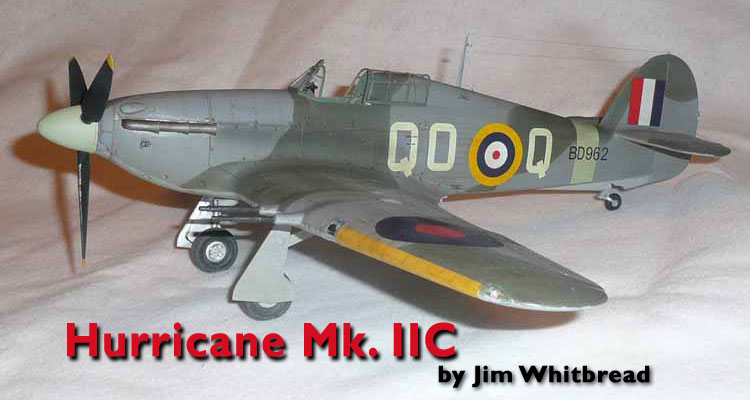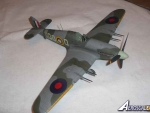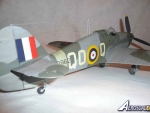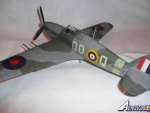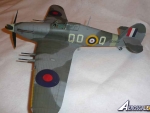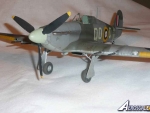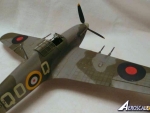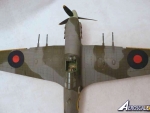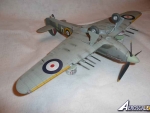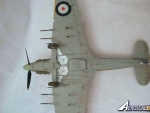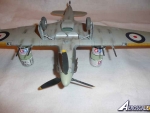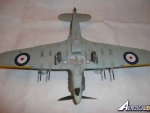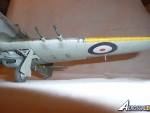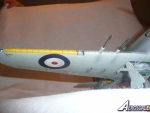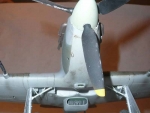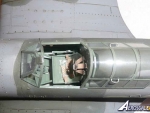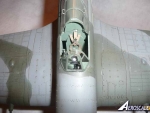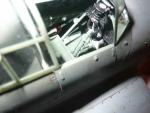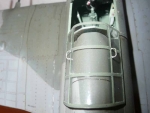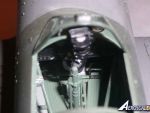1⁄24Hawker Hurricane Mk. IIC
...
Post a Comment
Historical Context
The Hawker Hurricane Mk IIC arose from an air ministry specification that called for a single seat day and night fighter. The specification included an armament requirement of four 20 mm cannon. When Hawker expressed interest in the project the Air Ministry was skeptical that the fighter was stout enough to handle stresses associated with this “up-armament”. The original Hawker Hurricane was armed with eight (8) .303 caliber machine guns.In addition to structural adequacy, availability of the 20 mm cannon threatened to be a problem which would kill the project. Nevertheless, testing proceeded with a Hurricane Mk I modified to accommodate a Swiss 20 mm cannon mounted in a fairing under each wing. This was followed by testing of a Mk I wing with twin internal mounted, drum fed cannon. Based on the results of these successful tests and increased availability of 20 mm cannons, the Air Ministry moved forward with conversion of existing airframes to the new configuration. Production Mk IIC aircraft utilized the Hispano-Suiza No. 1 Mk I 20 mm cannon. The first converted Hurricane took to the air in February 1941.
Production of over 4,700 Mk IIC models followed these initial tests. The RAF began receiving the UK based Mk IIC in September, 1941, just as the Battle of Britain was winding down and the Blitz beginning. The Mk IIC employed a liquid cooled V12, 1,200 HP Rolls Royce Merlin XX engine. It had a top speed of 340 mph at 21,000 with a service ceiling of 36,000 ft. It served the RAF in frontline service until 1947.
Trumpeter 1/24 Scale Hurricane Mk IIC
Before I started to build this kit I decided to make it an out of the box (OOB) experience. I rarely do this and with the exception of a few switches in the cockpit and the radio antenna, I succeeded. The instruction booklet is clear and logical. A separate color painting guide is also included with the instructions. Trumpeter has done a great job keeping the parts crisp and free of flash. Overall fit is outstanding and no filler was needed.The kit contains 10 parts and two clear parts trees, one photo-etch fret, rubber tires and engine leads and an instrument panel film. Recessed surface detail is good if not just a tad heavy. Decals are clear with bright, dense colors and crisp register. Kit construction follows the usual build the cockpit and engine, close up the fuselage and slap on the wings sequence. Cockpit and engine detail is ok but will not knock anybody’s socks off for sure. One clear part tree contains the engine panels. However, because of the lack of engine detail provided there was no real need to see the engine so these clear parts were painted.
Cockpit construction was straight forward. I used primarily Humbrol enamels for the majority of the kit. I love Humbrol paints. Once I had finished the cockpit it was painted RAF interior green, Humbrol 76. Details were picked out using Model Master black, red and yellow among others. The fuselage was then closed up and tail control surfaces constructed and attached.
Next comes the wings. Not only does the deep chord wing give outstanding real world aerodynamic stability, it also gives the modeler a big, tough piece of plastic to play with. You don’t have to worry about breaking this big boy. Included in the kit are basic and relatively bland cannon and ammunition drum parts. I decided not to show them and built my kit with the gun bay doors closed. The cannon will be a nice addition to my spares box.
Attaching the wings is a bit tricky to get a good joint. I decided to attach one side at a time because if you try to attach both sides simultaneously you won’t get the joints to line up. Landing gear, radiator, propeller and scratch-built antennae assemblies were next to round out construction. Once I’d finished construction I cleaned my model with warm water and dish soap. Next came the fun part, painting.
I decided to finish my Hurricane in RAF temperate European Theatre of Operations (ETO) matte colors; Dark Green (Humbrol 163), Dark Sea Grey (Humbrol 164) over Light Sea Grey (Humbrol 165) I chose to render a Hurricane from No. 3 Squadron circa 1942.
As I said earlier, I used mostly Humbrol enamels. In my opinion, Humbrol paints are great to work with. Based on my research, the Humbrol colors were pretty close to accurate with the exception of the Dark Sea Grey. In my opinion, it was too dark so I lightened it with Testors Flat White until I was satisfied with.
I began painting the undersides Light Sea Grey. Once finished I set it aside to dry. Please heed my warning about Humbrol paints. Make absolutely sure you mix them completely and allow them to dry. If you don’t you’ll likely end up with a glossy/sticky mess. That being said I allotted 48 hours for drying between colors.
Once dry I masked the undersides with Tamiya yellow masking tape and painted the upper surfaces Humbrol Dark Sea Grey. I only roughly followed the camouflage demarcation lines shown in my painting instructions since the last color to paint, Dark Green, will reproduce the actual lines.
After the Dark Sea Grey dried I masked the upper surfaces to produce camouflage using scale cutouts. To reproduce the hard edge of this RAF scheme I exploded the color painting instructions with a photocopier to the proper scale and taped these paper cutouts directly to my model. Once the paint was dry I removed the paper mask and sealed the airplane with Tamiya Clear X-22. The Tamiya clear product is an excellent acrylic which produces a clear, hard and glossy surface ideal for decal application.
Kit decals went on without a hitch. I chose markings for No. 3 Squadron circa 1942. Markings are also provided for a black night fighting Hurricane Mk IIC from No. 87 Squadron. In order to seat the decals I used a small amount of Micro-sol which was very effective.
In order to give the aircraft a “realistic” appearance I weathered the entire kit with a thin oil wash of burnt umber artist oils mixed with some flat black. Surface scratched and paint wear were shown by dry brushing silver in areas shown.
Well there you have it. Overall Trumpeter gives us a nice Mk IIc to adorn our collection. I can’t wait to tear into their 24th scale Bf 109 G next.
References
Hurricane in Action by Jerry Scutts, Squadron Signal Publications, 1986Great Fighters of the World, Hawker Hurricane by Mark Nichols, Key Publishing
Copyright ©2021 by Jim Whitbread. Images also by copyright holder unless otherwise noted. The views and opinions expressed herein are solely the views and opinions of the authors and/or contributors to this Web site and do not necessarily represent the views and/or opinions of AeroScale, KitMaker Network, or Silver Star Enterrpises. Images also by copyright holder unless otherwise noted. Opinions expressed are those of the author(s) and not necessarily those of AeroScale. All rights reserved. Originally published on: 2011-07-30 00:00:00. Unique Reads: 10045




